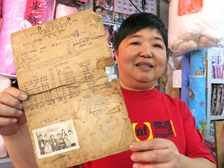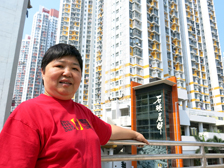
Long-term pact:
Shek Kip Mei Estate resident Lam Mei-sin safeguards her family’s first tenancy agreement, dating back to the 1950s.
Long-term pact:
Shek Kip Mei Estate resident Lam Mei-sin safeguards her family’s first tenancy agreement, dating back to the 1950s.

Tall order:
Miss Lam notes the newly re-built Shek Kip Mei Estate features great enhancements in design and facilities.
Tall order:
Miss Lam notes the newly re-built Shek Kip Mei Estate features great enhancements in design and facilities.

Comforter-able centre:
Miss Lam took over her father’s 47-year-old bedding shop in Shek Kip Mei Estate, more for social than commercial reasons: It is a popular gathering place for neighbours and friends.
Comforter-able centre:
Miss Lam took over her father’s 47-year-old bedding shop in Shek Kip Mei Estate, more for social than commercial reasons: It is a popular gathering place for neighbours and friends.

Happy days:
Chan Sing-tong, affectionately known as “Uncle Tong”, was among the first to move into So Uk Estate, and he has many fond memories of the place and the people who lived there.
Happy days:
Chan Sing-tong, affectionately known as “Uncle Tong”, was among the first to move into So Uk Estate, and he has many fond memories of the place and the people who lived there.

Estate guardian:
Uncle Tong never leaves home without his whistle, which identified him as one of the Mutual Aid Committee members who volunteered to patrol the grounds nightly, to give fellow residents peace of mind.
Estate guardian:
Uncle Tong never leaves home without his whistle, which identified him as one of the Mutual Aid Committee members who volunteered to patrol the grounds nightly, to give fellow residents peace of mind.
Residents recount housing advances
October 27, 2013
This year marks the 60th anniversary of Hong Kong’s public housing development. The basic resettlement blocks of the 1950s have evolved into housing estates with quality designs and comprehensive facilities that more than three million Hong Kong people - including Chan Sing-tong and Lam Mei-sin - are happy to call home.
Mr Chan, known affectionately as Uncle Tong, now 88 years young, was one of So Uk Estate’s original residents. He lived there for half a century, until the estate was cleared for redevelopment in 2012, and has many happy memories of the “most friendly neighbourhood”.
“Sometimes, when seniors were unable to go out to the markets, neighbours would buy food for them. Also, in the old days, not every family could afford to buy a refrigerator. Some families shared their fridges with neighbours to keep their food fresh. Neighbours were welcome to go inside their home to retrieve their food whenever they needed it. People would also go to hospitals to visit sick neighbours, and attended funerals when neighbours passed away,” he recalled.
He used to invite neighbours to watch programmes on his television as they did not have one of their own.
Estate guardians
Uncle Tong never leaves home without his little whistle, which identified him as one of the estate’s guardians. In the 1960s, the residents were frightened after a neighbour was murdered by a thief. To boost security and ease tenants’ minds, Uncle Tong gathered a group of strong men to form a Mutual Aid Committee. They patrolled the estate every night, in pairs or foursomes, equipped with bamboo sticks and whistles.
“The patrol team was a happy unit. Every night after patrolling the estate, we gathered in the committee room and chatted about all sorts of things, such as politics, work, or even world news. Some neighbours were very kind. They appreciated our work and served us delicious foods, such as dumplings, desserts and congee. We were quite happy then.”
He served So Uk Estate for decades, organising tours, gatherings and outdoor activities for his neighbours. He also witnessed the estate’s facilities’ enhancements, including more rest areas and car parks. When the estate was demolished for redevelopment, he and some neighbours moved into the nearby Un Chau Estate, where they now enjoy their retirement.
Crowded quarters, shared facilities
An urgent need for public housing was sparked by a fire on Christmas night in 1953 that razed through a Shek Kip Mei village of squatter huts. Overnight, more than 50,000 people lost their homes. In 1954, the Government built the first resettlement estate - the eight-block Shek Kip Mei Estate - to provide shelter for the blaze victims and squatter residents.
Lam Mei-sin, known as Auntie Sin, was among its first residents when she was a baby. Her parents had lost their humble home in the fire, and her then eight-member family squeezed into a 140-square-foot premises.
“Our home was divided into upper and lower parts, with a small loft where my five sisters and I slept and did our homework. Underneath, my parents had a workshop that doubled as their bedroom. They used to make handcrafted wedding items such as bouquets and corsages at home, and my sisters and I had to help with the assembly works,” she said.
The first resettlement estate consisted of six- or seven-floor blocks. The premises were tiny, without partitions or facilities. Residents had to cook in the corridors, and shared common toilets, bathrooms, and even water taps which were located in the middle of each floor.
“Most people queued up to use the common showers at six to seven o’clock in the evening. However, we usually had a shower at 11 o’clock or even midnight, as our father came home late. The door could not be locked, and anyone could easily look inside. So my sisters and I had to shower one by one and help each other keep lookout to avoid peeping Toms,” Miss Lam said.
Living standards rise
The Shek Kip Mei Estate redevelopment project got underway in the 1970s, and Miss Lam’s family was relocated to a newer building in the same estate. At 400 square feet, their new flat was nearly triple the size of the original one. For the first time, the Lam family had their own kitchen, bathroom and tap-water supply, a marked improvement in their living conditions.
This May, Miss Lam was relocated again - to the newly built Shek Kip Mei Estate. It features even greater enhancements in design and facilities.
“There are a lot of green areas outside the buildings, and most of the pathways have shelters or covers so that we will not get wet on our way home on rainy days. The new estate is equipped with lifts, escalators and ramps instead of stairs, making it more convenient for seniors and the disabled,” Miss Lam said.
Miss Lam has taken over her father’s bedding shop in the estate, which has been selling quilts and other linens for more than 47 years. Although it is not a great profit generator, she does not want to close the business as it is well known in the estate and is a popular gathering place for the old Shek Kip Mei neighbors.
Ongoing advances
Over six decades, Hong Kong’s public housing estates have been upgraded and modernised in terms of planning, design, building and management, to meet Hong Kong people’s changing needs.
Today, more than 3 million people live in public rental housing or subsidised home ownership flats, benefiting from the public housing programme. Most public housing residents live in the ‘Y’ shape blocks known as Harmony Blocks, which are easily configured into units of different sizes.
The Growing Up With Public Housing exhibition is now open at the Heritage Discovery Centre in Kowloon Park. Old photos and exhibits highlight the transformation of housing designs, and stir up memories of estate living in bygone days. For details, visit this
website.